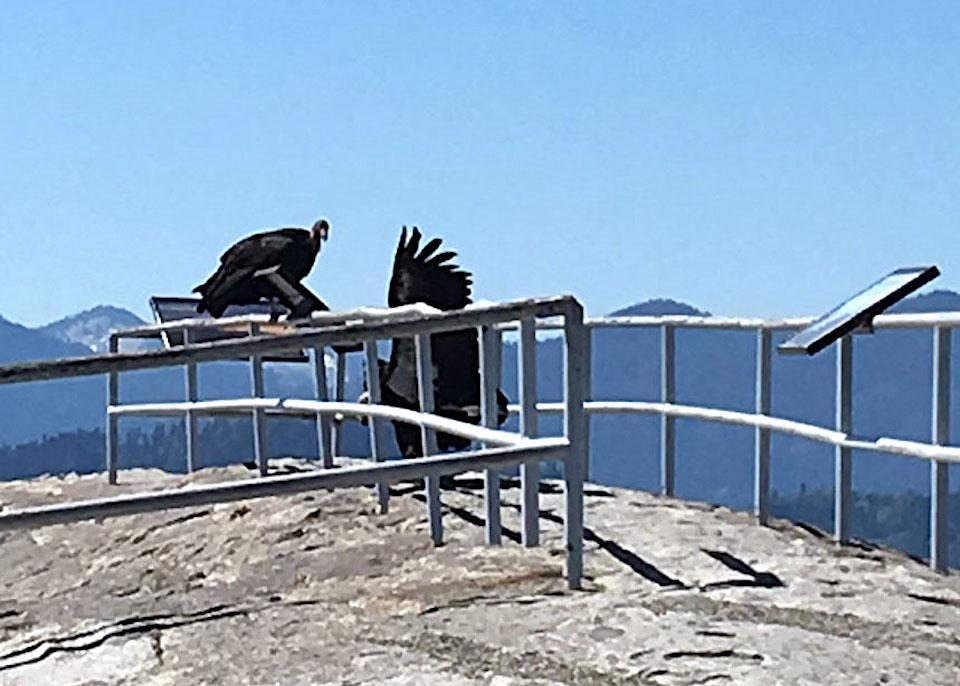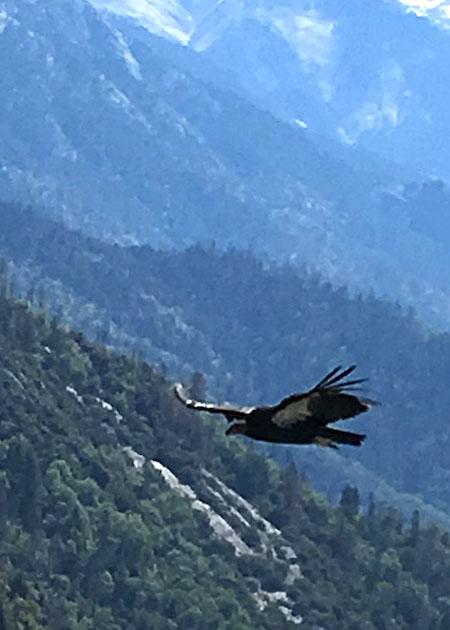
Moro Rock, a popular hiking destination in Sequoia National Park, also is proving popular with California condors/NPS, Wilson Garver
A few of the country's most iconic birds decided recently to take in the sights from Moro Rock in Sequoia National Park, making it the first time in nearly 50 years that California condors have been spotted in the park.
Recently reintroduced endangered California condors continue to reoccupy parts of their historic range, including the Sierra Nevada Mountains of California and adjacent foothills. Condors were seen atop Moro Rock, a popular hiking destination in Sequoia National Park, in late May. They are back to the towering trees and cliffs of the parks after being absent for nearly 50 years.

A California condor riding the thermals at Sequoia National Park/NPS, Wilson Garver
“Condors were consistently seen throughout the parks until the late 1970s. Observations became increasingly rare throughout the latter portion of the century as the population declined,” said Tyler Coleman, a wildlife biologist with Sequoia and Kings Canyon national parks, said. “Four condors were spotted flying near the Giant Forest and at least two near Moro rock.”
National Park Service staff weren’t the only ones to notice the birds in the parks.
“We use GPS transmitters to track the birds’ movement, which can be over hundreds of miles on a single day,” said Dave Meyer, a California condor biologist with the Santa Barbara Zoo. “On this particular day we documented the birds’ signals around Giant Forest, and we are excited that park employees observed the birds and confirmed their use of this important historic habitat.”
GPS data produced by these transmitters is used to identify important habitat, locate condor nesting and feeding activity, find sick or injured condors, and locate condors that have died in the wild.
Condors historically occupied the Sierra Nevada and were known to nest in the cavities of giant sequoia trees. By 1982 the wild population was reduced to 22 birds, all of which were eventually trapped and brought into captivity to prevent extinction of the species and save the remaining gene pool for use in a captive breeding program.
With the establishment of the successful captive breeding program at the Los Angeles Zoo and San Diego Wild Animal Park, in 1992 the U.S. Fish and Wildlife Service and partner organizations began releasing condors back into the wild in the mountains of the Los Padres National Forest in Southern California. This flock of condors has grown to approximately 100 through the continued release of captive bred birds and wild reproduction, and with the support of private and public agencies and organizations, local communities and landowners.
The Southern California flock continues to expand its geographic range as the population grows and now occupies portions of Ventura, Santa Barbara, Los Angeles, San Luis Obispo, Kern, Tulare, Fresno and Madera counties and the Sierra Nevada mountains and adjacent foothills.
Condors also occupy areas along California's Central Coast, at Pinnacles National Park, in Arizona at Grand Canyon National Park, in Utah at Zion National Park, and Baja California, Mexico, making up a total wild population of approximately 340 birds.
“As biologists, we are excited to see condors continue to expand back into their historic range. And also for the opportunity to engage with the local communities to share what they can do to contribute to the recovery of California condors, and also inform them about threats to these birds,” said Laura McMahon, a wildlife biologist with the USFWS California Condor Recovery Program.
Lead poisoning is the primary impediment to the recovery of the California condor, and is responsible for half of all deaths in which a cause is identifiable. Condors rely solely on scavenging for their food, meaning they do not hunt live prey, instead feeding on the carcasses of dead animals that often contain fragments of lead ammunition.
“Lead-core bullets shed weight in small fragments as they hit game, and have the potential to poison wildlife, including condors, who scavenge the remains,” said Chad Thomas, non-lead outreach coordinator for the Institute for Wildlife Studies. “The hunting and ranching communities are key partners in wildlife conservation. We continue to share information with these communities on how ammunition choices impact scavengers, and the ballistics of non-lead bullet options, so they can continue providing important food sources and valuable working landscapes for condors.”



Add comment